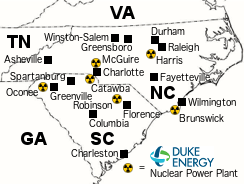

Russia and Restaurant Manager Bonnie Titone Duke IT Out Over Forced Meltdowns of Carolina Nuclear Power Plants
By Duane Thresher, Ph.D. January 28, 2022
As I have written, in Nuclear 9/11 for example, Russia, led by President Vladimir Putin, would love to attack the U.S. by hacking into nuclear power plants and forcing meltdowns, since it would prove that a catastrophic meltdown like Chernobyl in 1986 can't only happen to them. As it did in the hacking and ransomwaring of Colonial Pipeline (see U.S. Surrenders in IT War, Starts Paying Tribute to Russia), Russia will do this by determining the IT incompetent, regardless of sex or race (i.e. diversity), of those who are supposed to protect us from such cyberattacks — e.g. Chief Information Officers (CIOs) of nuclear power plants — and hacking into and forcing meltdowns of those insecure nuclear power plants. IT incompetent Marie Mouchet is the hacked woman CIO of Colonial Pipeline, and before that she was CIO of Southern Nuclear, which operates three nuclear power plants in Georgia and Alabama; IT incompetent Martin Davis is the black CIO of Southern Nuclear now (see also Ransomwared Nuclear Power Plants Upwind of Major U.S. Cities). Lest this be taken as a condemnation of the South, I wrote in Hacking and Forced Meltdown of Nuclear Power Plants: Upwind of Washington, Baltimore, Philadelphia about IT incompetent woman CIO Kelly Lyman of PECO, which operates the notoriously insecure Peach Bottom nuclear power plant in Pennsylvania. Here I write about IT incompetent — she only has a BS in restaurant management — Bonnie Titone, who is the woman CIO of Duke Energy, which operates six nuclear power plants spread throughout some of the most densely populated areas of North and South Carolina. Forced meltdowns of these old and already-unsafe nuclear power plants, and the resulting spread of radiation by wind and water, could horribly kill hundreds of thousands by radiation sickness. Apscitu can prevent this.
According to a Duke Energy press release, Bonnie Titone
 was hired as Duke Energy's Chief
Information Officer (CIO) in June 2019. "She will oversee
Duke Energy’s information technology operations and
infrastructure", which would include IT security (a.k.a. cybersecurity,
i.e. preventing hacking) of Duke Energy's nuclear power
plants.
was hired as Duke Energy's Chief
Information Officer (CIO) in June 2019. "She will oversee
Duke Energy’s information technology operations and
infrastructure", which would include IT security (a.k.a. cybersecurity,
i.e. preventing hacking) of Duke Energy's nuclear power
plants.Bonnie Titone is IT incompetent since she has no IT education; see The Most Important IT Credential: An IT Education in Principles of IT Incompetence. According to Bonnie Titone's own LinkedIn page, she only has a BS in hotel and restaurant management. This would include, for example, Motel 6 and McDonald's management. I've stayed in many hotels and motels and considered myself lucky if the Wi-Fi Internet access worked at all. No one should have to consider themselves lucky if their neighboring nuclear power plant isn't hacked into and forced to melt down.
As I have written, in Nuclear 9/11 for example, if a nuclear power plant is hacked into, a meltdown can be caused. All parts of a nuclear power plant, particularly the reactor control rods and cooling system, are controlled by computers and connected by a network, since humans can't be near many of these parts. Even hacking just the networked sensors could be used to force a meltdown by tricking the computers.
In Nuclear 9/11, I also explained about the horrors of radiation sickness, specifically the effects, including death rates, of different dosages of radiation. This assumed no medical treatment, but as was made clear from Coronavirus, for the millions affected there would be no medical treatment. (Speaking of Coronavirus, it is currently being used to scare people and make them ignore far more deadly dangers, like hacking and forced meltdowns of nuclear power plants.) It also assumed external exposure to radiation, but radioactive contamination that is ingested, e.g. in drinking water, or inhaled is far deadlier than external exposure to it. And note again that radiation sickness is equal opportunity death. It doesn't care about diversity; it kills regardless of sex or race ... or political affiliation.
Even for the lowest radiation dosage/death rate given, 10% of the population will be dead after 30 days, and more after that. 10% of the millions of people in cities near a single nuclear power plant is at least hundreds of thousands of people dead.
"Near" is within 150 miles, as I explained in Nuclear 9/11, the medically-advised radius around the Chernobyl nuclear power plant the Russian government seriously considered evacuating after the meltdown in 1986. The only reason they didn't evacuate to this radius was that logistical difficulty and appearances were more important to them than the safety of the people. Sound familiar? In the U.S., the Nuclear Regulatory Commission (NRC) only requires nuclear power plants to plan for an evacuation radius of 10 miles. To limit electric power losses due to transmission distances (I have a B.S. from MIT in Electrical Engineering and Computer Science), power plants are built as close to population centers as possible. Thus nuclear power plants are often built just a little more than 10 miles from major cities.
Kiev, which had a population of about 2.5 million people in 1986 and was de facto evacuated, is about 65 miles from Chernobyl, as the wind blows. In the mid-latitudes, as for Russia and the U.S., winds generally blow east but can blow north, south, or even west (I did graduate work in meteorology).
Kiev is also about 65 miles from Chernobyl as the water flows: the Pripyat/Dnieper River. Again, cooling is one of the most important things about nuclear power plants. Even nuclear power plants with iconic cooling towers, or similar, require a nearby lake, river, or ocean for cooling. The Chernobyl nuclear power plant, which had no cooling towers, used the Pripyat River, which flows into the Dnieper River that Kiev is on, which meant it could carry radioactive contamination there, which was a major concern.
In the U.S., east of the Appalachians, such as in North and South Carolina, water generally flows east towards the Atlantic Ocean (Gulf Stream) along rivers (and rivers turned into lakes and reservoirs), where cities are usually built.
Duke Energy operates six nuclear power plants in the Carolinas
 ; three in North Carolina (NC)
— McGuire (2 reactors), Harris (1 reactor), and
Brunswick (2 reactors) — and three in South Carolina
(SC) — Catawba (2 reactors), Robinson (1 reactor), and
Oconee (3 reactors). Their distances (miles) by air (wind)
from the 13 most populous city areas (the given populations
are minimums) in the Carolinas are given in the table below,
keeping in mind that radioactive fallout that reaches a more
distant city may go through a nearer city and that even a 10%
death rate will mean tens or hundreds of thousands of dead
from radiation sickness.
; three in North Carolina (NC)
— McGuire (2 reactors), Harris (1 reactor), and
Brunswick (2 reactors) — and three in South Carolina
(SC) — Catawba (2 reactors), Robinson (1 reactor), and
Oconee (3 reactors). Their distances (miles) by air (wind)
from the 13 most populous city areas (the given populations
are minimums) in the Carolinas are given in the table below,
keeping in mind that radioactive fallout that reaches a more
distant city may go through a nearer city and that even a 10%
death rate will mean tens or hundreds of thousands of dead
from radiation sickness.| City Area | Population | McGuire | Catawba | Harris | Robinson | Oconee | Brunswick |
| Charlotte NC | 2,660,000 | 15 | 15 | 110 | 65 | 115 | 180 |
| Raleigh NC | 1,414,000 | 125 | 140 | 15 | 125 | 245 | 125 |
| Greenville SC | 928,000 | 85 | 70 | 195 | 125 | 25 | 250 |
| Columbia SC | 829,000 | 95 | 70 | 165 | 55 | 115 | 165 |
| Charleston SC | 800,000 | 190 | 165 | 195 | 110 | 210 | 135 |
| Greensboro NC | 777,000 | 80 | 100 | 55 | 115 | 190 | 170 |
| Winston-Salem NC | 680,000 | 65 | 85 | 80 | 115 | 170 | 190 |
| Durham NC | 543,000 | 115 | 140 | 25 | 125 | 235 | 150 |
| Fayetteville NC | 527,000 | 115 | 125 | 40 | 85 | 220 | 85 |
| Asheville NC | 469,000 | 85 | 85 | 195 | 155 | 55 | 275 |
| Spartanburg SC | 328,000 | 65 | 45 | 170 | 110 | 55 | 225 |
| Wilmington NC | 283,000 | 190 | 190 | 110 | 125 | 280 | 15 |
| Florence SC | 206,000 | 100 | 95 | 110 | 25 | 180 | 95 |
Like Chernobyl, four of the six Duke Energy nuclear power plants don't have cooling towers, or similar, and they all require a nearby lake (including reservoirs and lakes made from rivers), river, or ocean for cooling. If there are meltdowns, these waterways will carry radioactive contamination hundreds of miles to the Atlantic Ocean (Gulf Stream) through densely populated areas, particularly cities
 , as follows.
, as follows.McGuire: Lake Norman for cooling ⇒ Mountain Island Lake ⇒ Catawba River ⇒ by Charlotte NC ⇒ Lake Wylie ⇒ Catawba River ⇒ Fishing Creek Lake ⇒ Lake Wateree ⇒ Wateree River ⇒ Lake Marion ⇒ Santee River ⇒ Atlantic Ocean (Gulf Stream) OR Lake Marion ⇒ Lake Moultrie ⇒ Cooper River ⇒ through Charleston SC ⇒ Atlantic Ocean (Gulf Stream)
Catawba: Lake Wylie for cooling ⇒ Catawba River ⇒ Fishing Creek Lake ⇒ Lake Wateree ⇒ Wateree River ⇒ Lake Marion ⇒ Santee River ⇒ Atlantic Ocean (Gulf Stream) OR Lake Marion ⇒ Lake Moultrie ⇒ Cooper River ⇒ through Charleston SC ⇒ Atlantic Ocean (Gulf Stream)
Harris: Harris Lake for cooling ⇒ Buckhorn Creek ⇒ Cape Fear River ⇒ through Fayetteville NC ⇒ Cape Fear River ⇒ by Wilmington NC ⇒ Cape Fear River ⇒ Atlantic Ocean (Gulf Stream)
Robinson: Lake Robinson for cooling ⇒ Black Creek ⇒ Prestwood Lake ⇒ Black Creek ⇒ Little Carr Creek ⇒ Great Pee Dee River ⇒ Waccamaw River ⇒ Atlantic Ocean (Gulf Stream)
Oconee: Lake Keowee for cooling ⇒ Keowee River ⇒ Lake Hartwell ⇒ Savannah River ⇒ through Augusta GA (population 611,000) ⇒ Savannah River ⇒ by Savannah GA (population 405,000) ⇒ Savannah River ⇒ Atlantic Ocean (Gulf Stream)
Brunswick: Cape Fear River for cooling ⇒ Atlantic Ocean (Gulf Stream)
Duke Energy's six nuclear power plants are old and already unsafe, making hacking into them and forcing meltdowns even easier.
After being constructed, mostly in the 1970s and 1980s, all nuclear power plants in the U.S. were issued operating licenses by the Nuclear Regulatory Commission (NRC) that were good for 40 years, the life expectancy of a nuclear power plant. After experiencing the ever-increasing expense and difficulty in constructing nuclear power plants, it was decided, well before the 40 years were up, to renew these operating licenses for another 20 years beyond the initial 40, i.e. 60 years total. See the table below, which was compiled here with data gathered from NRC records.
| Duke Energy | 40-Year | 20-Year | |
| Nuclear | Operating | Renewed | |
| Power Plant | License Issued | License Issued | License Expires |
| McGuire | |||
| Reactor 1 | May 1981 | Dec 2003 | Mar 2041 |
| Reactor 2 | May 1983 | Dec 2003 | Mar 2043 |
| Catawba | |||
| Reactor 1 | Jan 1985 | Dec 2003 | Dec 2043 [sic] |
| Reactor 2 | May 1986 | Dec 2003 | Dec 2043 [sic] |
| Harris | |||
| Reactor 1 | Oct 1986 | Dec 2008 | Oct 2046 |
| Robinson | |||
| Reactor 1 | Jul 1970 | Apr 2004 | Jul 2030 |
| Oconee | |||
| Reactor 1 | Feb 1973 | May 2000 | Feb 2033 |
| Reactor 2 | Oct 1973 | May 2000 | Oct 2033 |
| Reactor 3 | Jul 1974 | May 2000 | Jul 2034 |
| Brunswick | |||
| Reactor 1 | Sep 1976 | Jun 2006 | Sep 2036 |
| Reactor 2 | Dec 1974 | Jun 2006 | Dec 2034 |
Duke Energy's nuclear power plants, like all nuclear power plants constructed in the 1970s and 1980s, have some major age-related safety problems, making hacking into them and forcing meltdowns even easier.
The fuel for nuclear power plants, uranium dioxide in zirconium tubes, does not last forever and has to be replaced every few years. When it is, what is replaced, now nuclear waste, is still highly radioactive and still needs to be cooled or it can melt down or catch fire, spreading radioactivity widely; this was one of the biggest problems at Chernobyl.
These nuclear power plants were constructed in anticipation of a large permanent nuclear waste storage facility, with only limited temporary storage — spent fuel pools outside the reactor containment dome — constructed on-site at each nuclear power plant. The Yucca Mountain Nuclear Waste Repository in Nevada was to be this large permanent nuclear waste storage facility and was started in 1987, but was essentially cancelled in 2011 by President Barack Obama, without ever having stored any significant amount of nuclear waste.
These nuclear power plants have thus had to cram their nuclear waste in on-site spent fuel pools never designed to handle that density of nuclear waste (densities close to that inside a reactor). According to a report by Alvarez et al. in Science and Global Security in 2003, "The long-term land-contamination consequences of such an event [a spent fuel pool fire] could be significantly worse than those from Chernobyl."
Nuclear power plants, which generate electricity, have to have electricity even when they are shut down, in order to continue to cool the reactor, as well as the spent fuel pools. This electricity is usually taken from the electrical grid, which is just transmission lines controlled by networked computers. As a recent multi-billion dollar infrastructure bill in Congress pointed out, America's electrical grid is old and decrepit, including in regards to security (see CISA: No Infrastructure Cybersecurity, Just a Stepping Stone for IT Incompetents).
If hackers can get a nuclear power plant to just shut down (which some have just for hurricanes; Brunswick for example), they could force a meltdown by hacking the electrical grid (see Handing Over America's Electrical Grid to the Russians).
The Nuclear Regulatory Commission (NRC) and the nuclear power industry, as represented by the Nuclear Energy Institute (NEI), claim to have a cybersecurity plan that will prevent nuclear power plants from being hacked into. But a plan is not the same thing as its implementation, which depends on the qualifications of the implementors; that's the point of Stop IT Incompetence. Do you really think IT incompetent restaurant manager
 Bonnie Titone
Bonnie Titone
 can protect you and yours from
hackers
can protect you and yours from
hackers
 under Russian President
Vladimir Putin
under Russian President
Vladimir Putin
 hacking into one or more Duke Energy
nuclear power plants and forcing meltdowns that will horribly
kill millions from radiation sickness?
hacking into one or more Duke Energy
nuclear power plants and forcing meltdowns that will horribly
kill millions from radiation sickness?Apscitu can protect you and yours.
